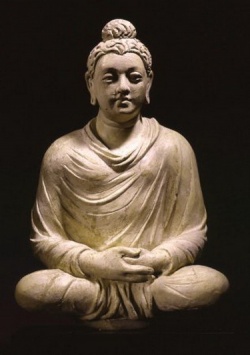Viññāna-kicca
viññāna-kicca: 'functions of consciousness', as exercised within a process of consciousness or cognitive series (cittavīthi). In the Abhidhamma Com. and Vis.M. XIV the following functions are mentioned:
- rebirth (patisandhi),
- subconsciousness (bhavanga),
- advertence (āvajjana),
- seeing, hearing, smelling, tasting, body-consciousness;
- receiving (sampaticchana),
- investigating (santīrana),
- determining (votthapana),
- impulsion (javana),
- registering (tadārammana),
- dying (cuti).
A single unit of sense-perception (e.g. visual consciousness), being conditioned through a sense-organ and its corresponding object, forms in reality an extremely complex process, in which all the single phases of consciousness follow one upon another in rapid succession, while performing their respective functions, e.g.:
"As soon as a visible object has entered the range of vision, it acts on the sensitive eye-organ (cakkhu-pasāda), and conditioned thereby an excitation of the subconscious stream (bhavanga-sota) takes place.
"As soon, however, as sub consciousness is broken off, the functional mind-element (s. Tab. I, 70), grasping the object and breaking through the subconscious stream, performs the function of 'adverting' the mind towards the object (āvajjana).
"Immediately thereupon there arises at the eye-door, and based on the sensitive eye-organ, the eye-consciousness, while performing the function of 'seeing' (dassana).... Immediately thereafter there arises the mind-element (Tab.I, 39, 55) performing the function of 'receiving' (sampaticchana) the object of that consciousness....
Immediately thereafter there arises... the mind-consciousness-element (Tab. I, 40, 41, 56), while 'investigating' (santirana) the object received by the mind-element...
"Immediately thereafter there arises the functional, rootless mind-consciousness-element (Tab. I, 71), accompanied by indifference, while performing the function of 'determining' (votthapana) the object......
"Now, if the object is large, then immediately afterwards there flash forth 6 or 7 'impulsive moments' (javana-citta), constituted by one of the 8 wholesome, or 12 unwholesome, or 9 functional classes of consciousness (Tab. I, 1-8; 22-23; 72-80).
Now, if at the end of the impulsive moments, the object at the five-sense doors is very large, and at the mind-door clear, then there arises, once or twice, one of the 8 root-accompanied, karma-resultant classes of consciousness (Tab. I, 42-49) of the sense-sphere, or one of the 3 rootless karma-resultant mind-consciousness-elements (Tab. I, 40, 41, 56).... Because this consciousness after the vanishing of the impulsive moments, possesses the faculty continuing with the object of the sub consciousness, taking the object of the sub consciousness as its own object, therefore it is called 'registering' (tadārarmmana, lit. 'that object', or 'having that as object')" (Vis.M. XIV, 115ff).
If, however, the sense-object is weak, then it reaches merely the stage of 'impulsion' (javana), or of 'determining' (votthapana); if very weak, only an excitation oft the sub consciousness takes place.
The process of the inner or mind-consciousness, i.e. without participation of the 5 physical senses, is as follows: in the case that the mind-object entering the mind-door is distinct, then it passes through the stages of 'advertence at the mind-door' (manodvārāvajjana), the 'impulsive stage' and the 'registering stage', before finally sinking into the subconscious stream. - (App.: citta-vīthi).
Literature:
- Aids to the Abhidhamma Philosophy, by Dr. C.B Dharmasena (with colour chart of the Cognitive Series; WHEEL 63/64).
- The Psychology and Philosophy of Buddhism, by Dr. W. F. Javasuriya (Buddhist Missionary Socy., Kuala Lumpur, Malaysia).

